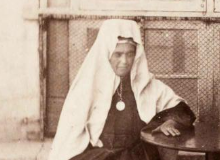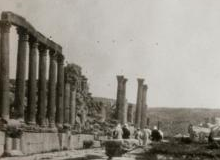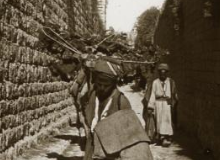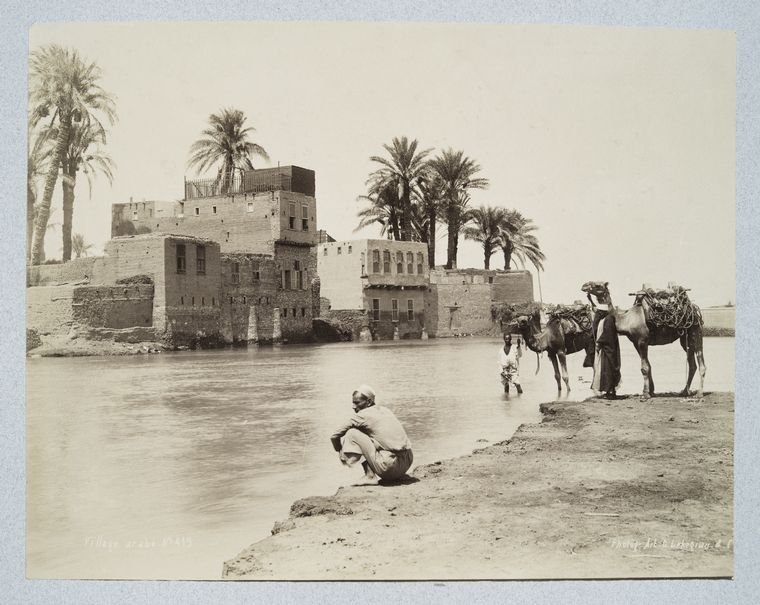Be it artistic, archaeological or ethnographic, photography accompanied travellers as of the mid-19th century.

-
Victor Fernique (1836-1915)

-
Marcel Jusserand Souvenirs d'Orient. 1908
-
Gabriel Lekegian Collection of views of Egypt, including Cairo and the pyramids. 1880-1889
-
André Robert (1883-1955)

-
Jean-Pascal Sebah Photos de monuments antiques. 1930
-
Jules Touzard (1867-1938)

-
Zangaki et Abdullah frères Album de 132 photos. 189.
Maxime du Camp (1822-1894)
Maxime Du Camp took photographs while travelling with Gustave Flaubert and for a book: Égypte, Nubie, Palestine et Syrie. Dessins photographiques recueillis pendant les années 1849, 1850 et 1851 (Gide & J. Baudry, 1852).
Catherine Pinguet, doctor of literature, associate researcher with the Centre of Turkish, Ottoman, Balkan and Central Asian Studies (CNRS-EHESS)
Beniamino Facchinelli (1829-1895)
Recently rediscovered, the photographer Beniamino Facchinelli (1839-1895) took over a thousand pictures of a monumental and picturesque Cairo.
Mercedes Volait, doctor of history and research director at the CNRS (InVisu laboratory of the Institut national d'histoire de l'art)
Felix Bonfils (1831-1885)
Félix Bonfils and his wife Lydie (1837-1918) came from Saint Hippolyte du Fort in the Gard. As a binder, then a printer, and finally a photographer trained by Niépce de Saint Victor, Félix Bonfils stayed in Lebanon in 1860 during France’s military expedition.
Sylvie Aubenas, director du département des Estampes et de la Photographie, BnF
Joseph-Philibert Girault de Prangey (1804-1892)
As an artist, scholar and early daguerreotypist, Joseph-Philibert Girault de Prangey became renowned as a pioneer of photography a century and a half after his journey to the Middle East.
Catherine Pinguet, doctor of literature, associate researcher with the Centre of Turkish, Ottoman, Balkan and Central Asian Studies (CNRS-EHESS)
Louis Vignes (1831-1896)
During a journey, lasting from June 1859 to October 1862, which took him from the south of France to Lebanon, via Sicily, Louis Vignes took 52 negatives on small format paper, and made his own prints on salted paper. It is a personal, documentary series, but of very great quality.
Sylvie Aubenas, director of the department of Stamps and Photography, BnF
Charles Theodule Deveria (1831-1871)
The practice of photography for Devéria was closely linked to the documentation of excavations and the framing of his prints should be understood in this context.
Sylvie Aubenas, director of the department of Stamps and Photography, BnF
Albert Goupil (1840-1884)
These documents are the work of a mediocre amateur who barely mastered the techniques of photography, but was unconcerned by this, given that they were reserved for private use, with no intention of publishing or exhibiting them.
Sylvie Aubenas, director of the department of Stamps and Photography, BnF
Gustave Le Gray (1820-1884)
Born in 1820 in the milieu of Parisian tradesmen, Le Gray soon abandoned his law studies, which his parents had desired, to devote himself to painting. In the studio of Paul Delaroche, he met two great future photographers, Charles Nègre and Henri Le Secq.
Sylvie Aubenas, director of the Department of Stamps and Photography, BnF
Emile Bechard. The new Cairo in 1874
In 1874, the photographer Émile Béchard provided a detailed panorama of the first buildings in the new quarter which the Khedive Ismail had started to create in Cairo, modelled on new Parisian housing developments.
Mercedes Volait, doctor of history and research director at the CNRS (InVisu laboratory of the Institut National d'Histoire de l'Art)


